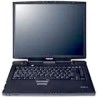Toshiba PS610U-NGYSG7 User Manual - Page 66
Selecting video cables, Connecting to the video-out port, on the left side of the computer.
 |
View all Toshiba PS610U-NGYSG7 manuals
Add to My Manuals
Save this manual to your list of manuals |
Page 66 highlights
66 Getting Started Using external display devices If you're connecting an SVGA monitor, skip to "Connecting an external monitor or projector" on page 67. Selecting video cables To connect a device to the video-out port, you'll need to purchase a composite video cable. For the best video quality, always use a properly shielded cable. HINT: Toshiba recommends using a cable no longer than 20 feet (approximately 6 meters). Using a poor quality cable may result in a dull or fuzzy picture, poor color, ghosting, video noise, or loss of video. Connecting to the video-out port NOTE: Video cables are not included with your computer. To connect a device to the video-out port, you'll need to purchase a composite video cable. To connect the device: 1 Connect one end of the video cable to the external video device. Refer to the documentation provided with the device for the location of its video-in port. 2 Connect the other end of the video cable to the video-out port on the left side of the computer. 3 Turn on the external video device. 4 Set the display mode by pressing Fn + F5, or by setting the Display Properties settings. For more information, see















